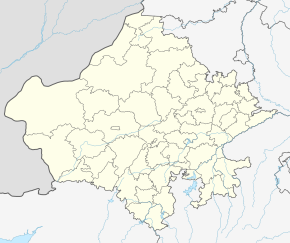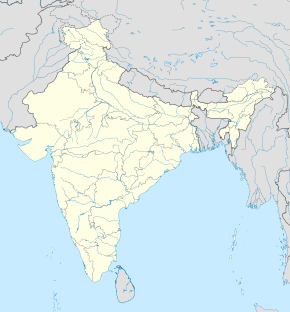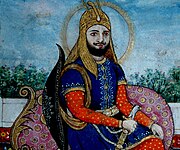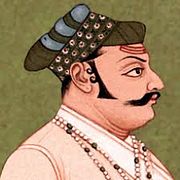Draft:Siege of Chittorgarh (1544)
| Siege of Chittorgarh | |||||||||
|---|---|---|---|---|---|---|---|---|---|
 | |||||||||
| |||||||||
| Belligerents | |||||||||
| Suri Dynasty |
| ||||||||
| Commanders and leaders | |||||||||
|
Sher Shah Suri Shams Khan Miyan Khan Sirawani Hussain Khan Khalji |
| ||||||||
| Units involved | |||||||||
|
At Chittor:- 3000 Cavalry | Unknown | ||||||||
Chittor(Capital of Mewar),Rajputana (Rajasthan) | |||||||||
The Siege of Chittorgarh was a pivotal moment in Sher Shah Suri's efforts to expand his influence in the region. By targeting the strategic Chittor Fort, he aimed to solidify his control over Rajputana and establish his authority in the area. The campaign was characterized by intense military tactics and strategic planning, as Sher Shah Suri sought to overcome the formidable defenses of the fort. The siege of Mewar showcased Sher Shah Suri's prowess as a military leader and highlighted his determination to assert his dominance in Rajasthan. The success of this conquest further solidified his reputation as a formidable ruler in the region.
Background[edit]
The Battle of Sammel was a significant military engagement that took place in 1544 between the forces of Sher Shah Suri and the Rajputs of Marwar. Sher Shah Suri emerged victorious in this battle, securing his control over the region and paving the way for further conquests in Rajasthan. The battle showcased Sher Shah Suri's military prowess and strategic acumen, solidifying his reputation as a formidable leader. The defeat of the Rajputs at Sammel marked a turning point in the power dynamics of the region, establishing Sher Shah Suri as a dominant force in Rajasthan.Sher Shah Suri's conquest of Marwar indeed brought the region under his control, and he then focused his attention on Mewar. As a powerful Afgan Ruler, he set his sights on the Chittor Fort in Mewar and launched a military campaign to gain control over the region of Rajputana. The Siege of Mewar was a significant event in Sher Shah Suri's quest for territorial expansion in Rajasthan, showcasing his determination and military strength as he aimed to extend his authority over the historic Chittor Fort.[5]
The Siege[edit]
When Sher Shah Suri was within a mere distance of 12 Kos from Chittor, Udai Singh II made the decision to surrender the fort without engaging in a direct confrontation. This resulted in the forfeiture of Chittor from the hands of Mewar, signifying the loss and defeat of the fortress without a pitched battle being fought.[6][7][8]
Other Conquests[edit]
After subjugating Maharana Udai Singh of Mewar, Sher Shah Suri turned his attention towards Kumbhalgarh, which was controlled by Toda Rai Singh. Following a brief siege, the fortress was conquered, and Sher Shah appointed governors to oversee Mewar and Kumbhalgarh. He then proceeded to Ranthambore, where he successfully captured and upgraded the fort.[9][10][11]
Battle of Harmoda (1557)[edit]
| Battle of Harmoda | |||||||
|---|---|---|---|---|---|---|---|
| |||||||
| Belligerents | |||||||
|
Suri Dynasty Kingdom of Marwar |
| ||||||
| Commanders and leaders | |||||||
|
Haji Khan Maldeo Rathore |
| ||||||
Despite focusing on rebuilding his kingdom and his new capital, Udai Singh II faced ongoing challenges with neighboring kingdoms. Maldeo of Marwar, who had previously supported Rana Vikram, found himself at odds with Mewar by 1556. Haji Khan, who had risen to power in Ajmer and Nagaur after being a slave of Sher Shah Suri, became a key player in the region. Maldeo of Marwar launched an attack against Haji Khan, but with support from Udai Singh II and Rao Kalyanmal of Bikaner, Haji Khan managed to fend off Maldeo's forces. However, the alliance between Udai Singh II and Haji Khan quickly soured, with one account suggesting it was over a dispute involving a dancer demanded by Udai Singh as payment for his assistance. Seeking revenge, Haji Khan turned to Maldeo for aid, leading to a decisive battle at Harmoda in January 1557 where Maldeo and Haji Khan's combined forces defeated Udai Singh II's army, with assistance from Jaimal of Merta. This clash marked a significant turning point in the complex political landscape of the region at the time.[13]
Aftermath[edit]
During his reign, Sultan Sher Shah Suri achieved a significant military conquest in the region of Rajputana. He successfully subjugated core areas such as Chittorgarh, Kumbhalgarh,Ranthambore, Mewar, Marwar (including Jodhpur), Ajmer, and Nagaur, bringing them under his control.[14][15][16][17]
References[edit]
- ^ Gandhi, A. K. (2021-01-01). Maharana Pratap Indias Warrior King: MAHARANA PRATAP INDIAS WARRIOR KING: The Heroic Saga of Rajasthan. Prabhat Prakashan.
- ^ Rana, Bhawan Singh (2014-03-24). Maharana Pratap. Diamond Pocket Books Pvt Ltd. ISBN 978-93-5083-869-3." It was during his reign in 1544 when Shershah Suri, after his victory over Jodhpur, headed for Chittor, Udai Singh offered no resistance and in a cowardly display of timidity, chose to send the keys to the invader in place of confronting him in the battleground. Shershah too thought it right not to engage the Rajputs unnecessarily, he accepted the terms of surrender, appointed Shams Khan, his representative, as the governor, and allowed Udai Singh to continue to rule under his guidance."
- ^ Chaurasia, Radhey Shyam (2002). History of Medieval India: From 1000 A.D. to 1707 A.D. Atlantic Publishers & Dist. p. 181. ISBN 978-81-269-0123-4.
- ^ Chaurasia, Radhey Shyam (2002). History of Medieval India: From 1000 A.D. to 1707 A.D. Atlantic Publishers & Dist. p. 181. ISBN 978-81-269-0123-4."(1). Malwa. In 1542 Sher Shah invaded Malwa after subduing Gwalior. The Fort of Ranthambhor was surrendered to Sher Shah.(2)Mewar. Then Sher Shah paid his attention towards Mewar and in 1544, he easily won Chittor and Ajmer."
- ^ Cambridge History Of India, Vol. 4, The Mughul Period. pp. 54–55.
- ^ Gandhi, A. K. (2021-01-01). Maharana Pratap Indias Warrior King: MAHARANA PRATAP INDIAS WARRIOR KING: The Heroic Saga of Rajasthan. Prabhat Prakashan.
- ^ Rana, Bhawan Singh (2014-03-24). Maharana Pratap. Diamond Pocket Books Pvt Ltd. ISBN 978-93-5083-869-3." It was during his reign in 1544 when Shershah Suri, after his victory over Jodhpur, headed for Chittor, Udai Singh offered no resistance and in a cowardly display of timidity, chose to send the keys to the invader in place of confronting him in the battleground. Shershah too thought it right not to engage the Rajputs unnecessarily, he accepted the terms of surrender, appointed Shams Khan, his representative, as the governor, and allowed Udai Singh to continue to rule under his guidance."
- ^ Sharma, G. N. (1954). Mewar and the mughal emperors.
- ^ Pal, Hamendar Bhisham (1974). Historic Rajasthan. Sagar Publications. p. 43.
- ^ Hooja, Rima (2006). A History of Rajasthan. Rupa & Company. p. 529. ISBN 978-81-291-0890-6.
- ^ Chaurasia, Radhey Shyam (2002). History of Medieval India: From 1000 A.D. to 1707 A.D. Atlantic Publishers & Dist. p. 181. ISBN 978-81-269-0123-4."(1). Malwa. In 1542 Sher Shah invaded Malwa after subduing Gwalior. The Fort of Ranthambhor was surrendered to Sher Shah.(2)Mewar. Then Sher Shah paid his attention towards Mewar and in 1544, he easily won Chittor and Ajmer."
- ^ Hooja, Rima (2006). A History of Rajasthan. Rupa & Company. p. 462. ISBN 978-81-291-0890-6."(. By then, Haji Khan, a former slave belonging to Emperor Sher Shah Suri, had become master of Ajmer and Nagaur).*Haji Khan now approached his former antagonist, Marwar's Rao Maldeo, and sought help against Udai Singh of Mewar. Maldeo agreed, and in January 1557 Maldeo and Haji Khan's combined troops met and defeated the forces of Udai Singh of Mewar at the battle of Harmoda. (Mewar's army was assisted by Jaimal of Merta and his troops)."
- ^ Hooja, Rima (2006). A History of Rajasthan. Rupa & Company. p. 462. ISBN 978-81-291-0890-6.
- ^ Chaurasia, Radhey Shyam (2002). History of Medieval India: From 1000 A.D. to 1707 A.D. Atlantic Publishers & Dist. p. 181. ISBN 978-81-269-0123-4."(1). Malwa. In 1542 Sher Shah invaded Malwa after subduing Gwalior. The Fort of Ranthambhor was surrendered to Sher Shah.(2)Mewar. Then Sher Shah paid his attention towards Mewar and in 1544, he easily won Chittor and Ajmer."
- ^ Hooja, Rima (2006). A History of Rajasthan. Rupa & Company. p. 462. ISBN 978-81-291-0890-6.
- ^ Gandhi, A. K. (2021-01-01). Maharana Pratap Indias Warrior King: MAHARANA PRATAP INDIAS WARRIOR KING: The Heroic Saga of Rajasthan. Prabhat Prakashan.
- ^ Rana, Bhawan Singh (2014-03-24). Maharana Pratap. Diamond Pocket Books Pvt Ltd. ISBN 978-93-5083-869-3." It was during his reign in 1544 when Shershah Suri, after his victory over Jodhpur, headed for Chittor, Udai Singh offered no resistance and in a cowardly display of timidity, chose to send the keys to the invader in place of confronting him in the battleground. Shershah too thought it right not to engage the Rajputs unnecessarily, he accepted the terms of surrender, appointed Shams Khan, his representative, as the governor, and allowed Udai Singh to continue to rule under his guidance."





